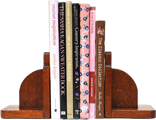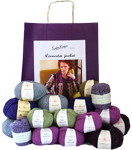Interviews
‘The Classic Collection’
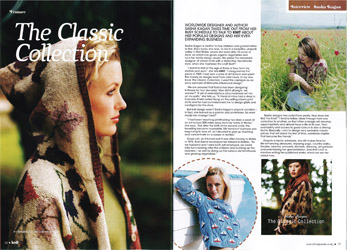
An interview from ‘Knit’ magazine, 2012.
Read the full article here (4.56mb .pdf file).
‘The Big Interview’
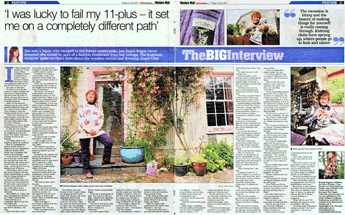
An interview from the ‘Western Mail’ daily paper, 3 June 2011.
Read the full article here (802kb .pdf file).
‘Countryside Knitting’
from ‘Knitting’ magazine, December 2008
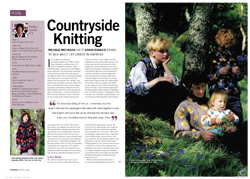
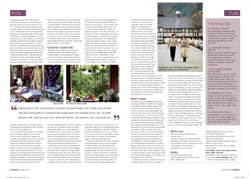
Michele Matheson visits Sasha Kagan’s studio to talk about her career in knitwear.
Read the full article here (.pdf file).
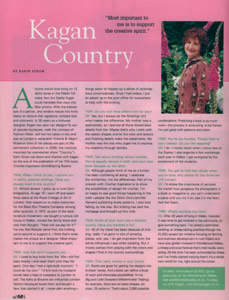
‘Kagan Country’
An interview with Sasha Kagan, by Karin Strom, published in ‘Yarn Market News’ magazine October 2007.
“Most important to me is to support the creative spirit.”
Anyone would love living on 13 idyllic acres in the Welsh hillsides; few but Sasha Kagan could translate that view into fibre artistry. With the trained eye of a painter, she renders nature into knits heavy on texture (her signature: twisted ribs) and colorwork. In 30 years as a knitwear designer, Kagan has seen her designs fly out of upscale boutiques, walk the runways of Fashion Week, sell like hot cakes in kits and star at London’s venerable Victoria & Albert Museum (two of her pieces are part of the permanent collection; in 2000, the institute mounted her one-woman show ‘Country’). Karin Strom sat down and chatted with Kagan on the eve of the publication of her fifth book, Crochet Inspiration (Sixth & Spring Books).
YMN: When I think of you, I picture you in idyllic, pastoral settings. Have you always lived in the country?
SK: Almost always. I grew up in rural Cambridgeshire. At age 19 I went off and spent three years at the Royal College of Art in London, then stayed on to make costumes for the Black Box Theatre Company, among other pursuits. In 1972, as part of the back- to-nature movement, we bought a ruinous old house in Wales, moved the family there and only then thought, “How will we pay for it?” For me, the lifestyle came first; the knitting came second to support it. I think that’s what makes me unique as a designer. Most important to me is to support the creative spirit.
YMN: And that spirit supports you.
SK: I used to buy knits from the ‘40s—old Fair Isles mostly—and wear them until they fell apart. One day I had a light-bulb moment: “I could do my own.” I’d knit and my husband would take a load of sweaters to London to sell. The folks at Browns (an influential London fashion boutique) loved them and bought a few; that started it all. I never plan anything - things seem to happen by a series of serendipitous circumstances. Once I had orders, I put an advert up in the post office for outworkers to help with the knitting.
YMN: Do you still have others knit for you?
SK: Yes, but I always do the finishing—it’s what makes the difference. My mother was a seamstress, so I learned all those dressmaker details from her. Maybe that’s why I stick with the classic shapes and let the color and texture and finishing details make the statements. My mother was the one who urged me to express my creativity through textiles.
YMN: Talk about knitting versus crochet. You’re equally versed in both, and your new book focuses on the latter.
SK: Although people think of me as a knitter, I’ve been crocheting all along. I celebrate the similarities, not the differences. Part of my mission with Crochet Inspiration is to show the possibilities of design for crochet. I’m so happy to see good things happening in the craft—people like the Stitch Diva (Jennifer Hansen) publishing lovely patterns. I also love felting, by the way. But knitting has paid the mortgage and brought up four kids.
YMN: Much of your work has a folkloric quality. Have you traveled a lot?
SK: All of my travel has been because of knitting, really. I’ve gone to lots of amazing places, and, yes, I do get inspiration from the ethnic influences I see while traveling. But it mostly comes from playing with the colors and shapes I find in my country surroundings.
YMN: That really shows in your books.
SK: Books are great for getting the designs into knitters’ hands. And a book can define a body of work and showcase possibilities. In my Big and Little Sweaters (Westminster Trading), for example, there are six basic shapes, six sizes, 25 patterns. That’s about 2,500 possible combinations. Producing a book is so much work - the process is exhausting, to be honest. I’m just good with patterns and colors.
YMN: You’re too humble. People flock to your classes. Do you like teaching?
SK: I do. I mostly teach when I come here to the States; I also organize a few workshops each year in Wales. I get energized by the excitement of the students.
YMN: You get to visit yarn shops when you’re here. Any advice for the American LYS owner?
SK: I’d stress the importance of samples. No matter how gorgeous the photography in a book or magazine is, you can’t understand a piece until you try it on, see it in the flesh, feel the fibres.
YMN: What’s exciting you now?
SK: After 30 years of living in Wales, I decided it was time to get involved in the community, to give something back. I’ve joined a committee working on sheep-raising practices through the GLASU project (an initiative focusing on farming and business development in rural Wales) and have also gotten involved in Wonderwool Wales, a sheep-and-wool festival that’s held locally every spring. All this time I’ve been surrounded by sheep and I’ve finally started noticing them! It’s a whole new world for me, right around the corner.
To learn more about GLASU and Wonderwool Wales, go to GLASU or Wonderwool Wales.
